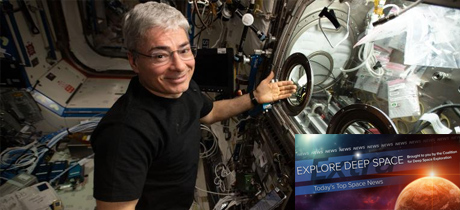In Today’s Deep Space Extra… Two NASA astronauts embark on a spacewalk Tuesday to continue an upgrade of the International Space Station’s solar power generation system. Inside the Station, NASA astronaut Mark Vande Hei will set a record for the longest spaceflight by an American at 12:24 p.m. EDT. The Artemis I SLS/Orion rollout for Wet Dress Rehearsal remains on schedule for Thursday.
Human Space Exploration
NASA astronauts will conduct a spacewalk to provide Space Station power upgrades
CNN (3/14): NASA astronauts Kayla Barron and Raja Chari were to embark on a planned 6 ½-hour spacewalk outside the International Space Station (ISS) early Tuesday. They will prepare the starboard side of the ISS’s solar power truss for its first ISS Roll Out Solar Array (iROSA) upgrade in the coming months by installing attachment hardware called a “Modkit.” Two iROSAs were attached to the truss’s port side in 2021. In all, NASA plans to equip six of the ISS’s eight solar power channels with iROSAs to extend and increase the station’s power generation. NASA is broadcasting the spacewalk on NASA TV and streaming on www.nasa.gov/nasalive. This spacewalk’s scheduled start time is 8:05 a.m. EDT.
Astronaut Mark Vande Hei breaks record for longest U.S. spaceflight
Collectspace.com (3/15): NASA astronaut Mark Vande Hei, who has been living and working aboard the International Space Station (ISS) since last April, is poised to break the U.S. record for the longest single spaceflight on Tuesday at midday. The record was 340 days, set by now retired NASA astronaut Scott Kelly over 2015-16. Vande Hei’s long stay will contribute to research needed to address the physical and mental health challenges of future NASA missions to the Moon and Mars.
Montalbano: ISS team still working together, Vande Hei definitely returning on Soyuz
Coalition Members in the News – Axiom Space, Boeing
Spacepolicyonline.com (3/14): NASA’s Joel Montalbano, International Space Station (ISS) program manager, offered assurances on Monday that NASA astronaut Mark Vande Hei will be coming back to Earth aboard Russia’s MS-19 on March 30, despite growing global tensions over Russia’s incursion into Ukraine. “I can tell you for sure: Mark is coming home on that Soyuz,” Montalbano told a news briefing on Monday afternoon. “We are in communication with our Russian colleagues; there’s no fuzz on that.” Some social media commentary had suggested Russia might leave him behind, and Russian media had released a video that showed Vande Hei hypothetically being left behind.
All systems go for Thursday rollout of NASA’s Artemis 1 Moon mission
Space.com (3/14): The rollout of NASA’s Artemis I Space Launch System (SLS) rocket and Orion crew capsule from the Vehicle Assembly Building (VAB) at NASA’s Kennedy Space Center (KSC) to launch pad 39B remains on schedule for Thursday, agency officials told a news briefing late Monday afternoon. First motion with the rocketry atop the Crawler Transporter-2 is planned for 5 p.m. EDT. The journey to the pad is 4 miles long and is estimated to take around 11 hours. Officials said at the news conference that they are targeting April 3 for the Wet Dress Rehearsal (WDR).
Space Science
If axions are dark matter, we’ve got new hints about where to look for them
Universetoday.com (3/14): The composition and source of “dark matter” have long posed a mystery for astronomers. Since the 1970s it has been proposed that axions, massive particles that interact weakly with light, could be the source. But so far, efforts to link axions with dark matter have come up short. Now, a Princeton University-led research effort that turned to computer modeling suggests that after the early universe emerged from inflation, axion particles could have been flung into less dense regions of the cosmos than those that are ripe with galaxies. The study has been published in the journal Nature Communications.
NASA’s DART asteroid-slamming mission builds on tiny diamond-tipped tool tech
Space.com (3/15): The Double Asteroid Redirection Test (DART) mission launched in November and will arrive at its destination in late September. While its purpose is to impact an asteroid to change its orbit, just how much the orbit will change is difficult to predict. Leading up to the mission, scientists used samples collected from two space rocks to understand the future impact. The work relied on a precision pressing tool known as a nanoindenter, which has a pyramid-shaped diamond tip measuring only a few millionths of a millimeter.
Other News
SNL’s Pete Davidson will fly to space next week with Jeff Bezos’ Blue Origin
Space.com (3/14): Scheduled to launch March 23 from East Texas, Blue Origin’s next suborbital New Shepard mission will include six passengers. They are Pete Davidson, of Saturday Night Live; George Nield, former associate administrator for the Federal Aviation Administration’s (FAA) Office of Commercial Space Transportation; angel investor Marty Allen; Sharon Hagle, founder of the SpaceKids Global nonprofit; Marc Hagle, CEO of Tricor International, property developers; and Jim Kitchen, a University of North Carolina business professor.

